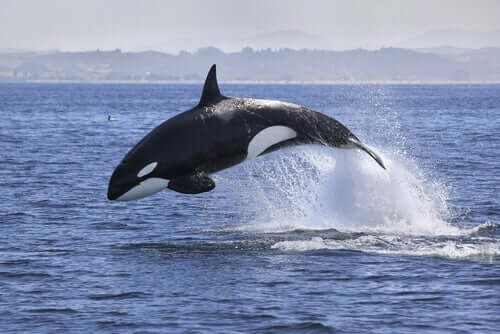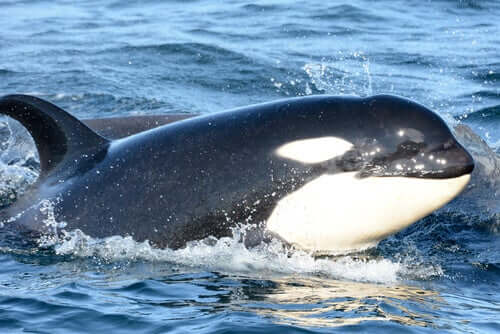Meet the Killer Whale: Behavior, Habitat and Characteristics

The killer whale (Orcinus orca), is one of the most famous cetaceans on the planet. It has, however, an undeserved reputation as a dangerous animal. Nevertheless, it possesses some fascinating traits and behaviors that we can observe in its hunting strategies.
Characteristics of the killer whale
The killer whale or “Orca” is a cetacean of the family “Odontocete” that groups every toothed marine mammal, just like dolphins. In fact, they belong to the same family, being the largest member of the oceanic dolphin family in the world.
Despite their massive weight, killer whales possess a very hydrodynamic body. Males can weigh up to 5.5 tonnes while the females are around 4 tonnes. In addition to being heavier, males have a larger dorsal fin, which usually reaches 6.5 feet long.
These animals are unmistakable because of the black and white coloration on their bodies. Killer whale spots are unique to each individual, and no two whales are alike. These spots can be used in many studies to distinguish them from each other.
Killer whales can live long lives, even though mortality rates are very high during their first 6 months of life. For this reason, their average life expectancy doesn’t exceed 30 years. However, once they are over the juvenile stage, they can live up to 90 years, and most adult killer whales live to be 60 years old.
Habitat
This species is widely distributed on the planet, living in most of the world’s oceans. In fact, it’s the cetacean with the highest habitat distribution. The coasts of the Arctic, Russia, Japan, South Africa, Australia or Spain are just some examples of its extreme ecological success.
There are many different populations of killer whales, which have adapted to different habitats. Many of them will also migrate every year. These movements coincide with changes in climate and, above all, with their prey’s migrations.
This tremendous distribution makes it very difficult to estimate the total number of killer whale populations. Nevertheless, experts have estimated that the world population of killer whales is at least 50,000 individuals. With no census in much of the world’s oceans, the numbers could be much higher. However, even if these numbers are high, this species is increasingly threatened by death by pollution in the oceans.
Behavior
Killer whales form complex social structures, where descent is determined by the “mother” line. That is, the family unit is composed of several generations of females.

These animals have strong social bonds, similar to those of the great apes or elephants. They can form groups of up to 100 individuals, although most groups consist of around 10 individuals.
In regards to communication, killer whales use different “dialects” depending on the area they live in. Thus, for every “dialect”, they’ll use specific singing “repertoires”. Moreover, these differences also exist between the different killer whale clans.
Therefore, two killer whales from two different parts of the world may not understand each other. However, experts have also observed that they can learn dialects from each other, as they transmit these languages culturally.
Hunting strategies
Culture is the body of knowledge that a species can transmit from generation to generation. Just as with their “dialects”, their hunting strategies differ among the different groups living on the planet.
All these strategies are possible thanks to the excellent teamwork that exists between the members of the clan. Because of this, they’re even able to kill some of the biggest animals in the world, like the blue whale.
For instance, orcas that live in the Scandinavian fjords eat herring by encircling shoals or schools of fish. They spin around them forming a sphere in which the herrings end up surrounded and helpless.
Another strategy they also use is to eject bubble jet streams at their prey as well as producing loud sounds. They’ll also strike a group of fish with their tails so they can eat those that don’t recover. However, one of their best moves is against animals that sit on blocks of ice. For this, they swim together in sync under the ice and make the animal fall into the water by creating waves that shake the ice blocks.
More techniques
In the Mediterranean Sea, orcas are famous for stealing food from fishing boats. They cleverly wait for the boat to start lifting the huge fishnet out of the water to get their bounty. In fact, there are records of killer whales collaborating with humans for hunting, like the story of Old Tom.
In Argentina, orcas dive off the Patagonian coast to catch sea lions and penguins. Meanwhile, in Gibraltar, they chase after bluefin tuna and exhaust them by racing until they can no longer swim.
These are just a few examples of just how smart and intelligent killer whales can be. However, there are still many fascinating aspects of orca behavior that we haven’t discovered yet. We just hope we can still study these fascinating animals while still working to eliminate the ocean’s pollution and combat climate change.
All cited sources were thoroughly reviewed by our team to ensure their quality, reliability, currency, and validity. The bibliography of this article was considered reliable and of academic or scientific accuracy.
- Dimery, R. (2019). The animal from which great whites flee: 5 killer records held by orcas. Guinness World Records. Recuperado el 20 de enero de 2022, disponible en:https://www.guinnessworldrecords.com/news/2019/6/the-animal-from-which-great-whites-flee-five-killer-records-held-by-orcas-576308
- Bega Shire’s Hidden Heritage, 101 Objects Revealed. (2019). Eden Killer Whale Museum. Old Tom’s Skeleton. Recuperado el 20 de enro de 2022, disponible en: https://hiddenheritage.com.au/heritage-object/?object_id=8
